Page 1602 of 4264
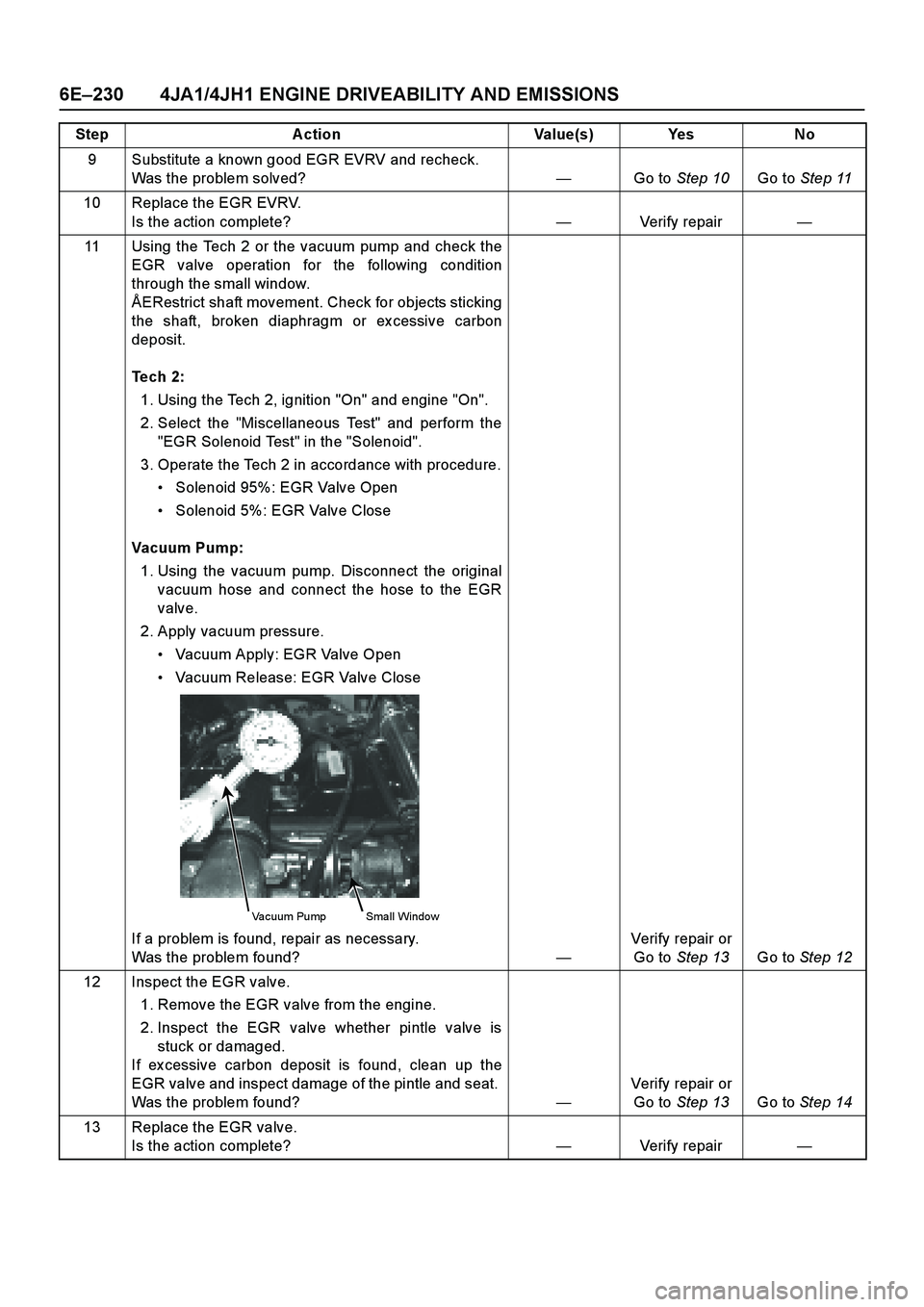
6E–230 4JA1/4JH1 ENGINE DRIVEABILITY AND EMISSIONS
9 Substitute a known good EGR EVRV and recheck.
Was the problem solved?—Go to Step 10Go to Step 11
10 Replace the EGR EVRV.
Is the action complete?—Verify repair—
11 Using the Tech 2 or the vacuum pump and check the
EGR valve operation for the following condition
through the small window.
ÅERestrict shaft movement. Check for objects sticking
the shaft, broken diaphragm or ex cessive carbon
deposit.
Tech 2:
1. Using the Tech 2, ignition "On" and engine "On".
2. Select the "Miscellaneous Test" and perform the
"EGR Solenoid Test" in the "Solenoid".
3. Operate the Tech 2 in accordance with procedure.
Solenoid 95%: EGR Valve Open
Solenoid 5%: EGR Valve Close
Vacuum Pump:
1. Using the vacuum pump. Disconnect the original
vacuum hose and connect the hose to the EGR
valve.
2. Apply vacuum pressure.
Vacuum Apply: EGR Valve Open
Vacuum Release: EGR Valve Close
If a problem is found, repair as necessary.
Was the problem found?—Verify repair or
Go to Step 13Go to Step 12
12 Inspect the EGR valve.
1. Remove the EGR valve from the engine.
2. Inspect the EGR valve whether pintle valve is
stuck or damaged.
If ex cessive carbon deposit is found, clean up the
EGR valve and inspect damage of the pintle and seat.
Was the problem found?—Verify repair or
Go to Step 13Go to Step 14
13 Replace the EGR valve.
Is the action complete?—Verify repair— Step Action Value(s) Yes No
Vacuum Pump Small Window
Page 1605 of 4264
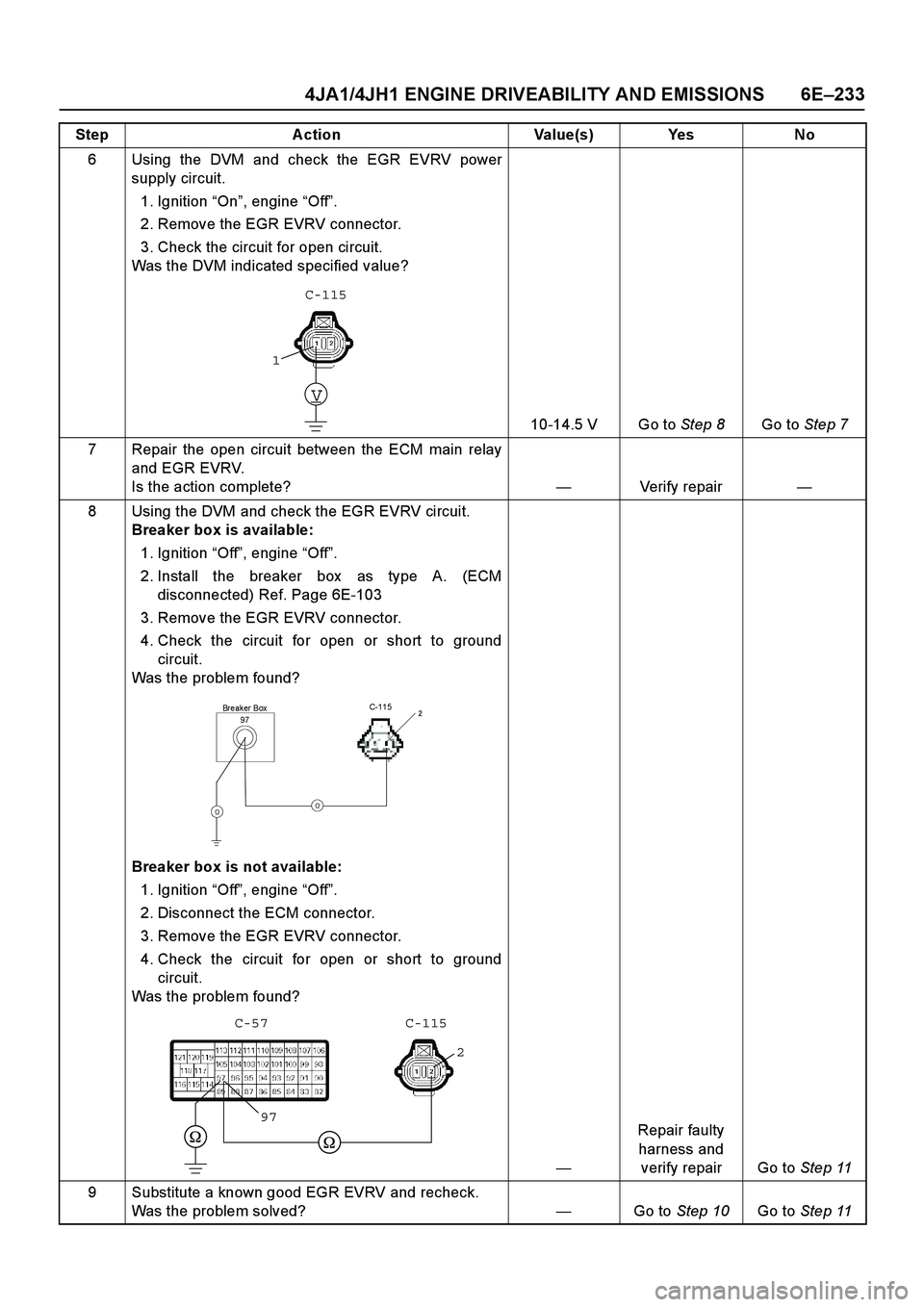
4JA1/4JH1 ENGINE DRIVEABILITY AND EMISSIONS 6E –233
6 Using the DVM and check the EGR EVRV power
supply circuit.
1. Ignition “On ”, engine “Off ”.
2. Remove the EGR EVRV connector.
3. Check the circuit for open circuit.
Was the DVM indicated specified value?
10-14.5 V Go to Step 8Go to Step 7
7 Repair the open circuit between the ECM main relay and EGR EVRV.
Is the action complete? —Verify repair —
8 Using the DVM and check the EGR EVRV circuit. Breaker box is available:
1. Ignition “Off ”, engine “Off ”.
2. Install the breaker box as type A. (ECM disconnected) Ref. Page 6E-103
3. Remove the EGR EVRV connector.
4. Check the circuit for open or short to ground circuit.
Was the problem found?
Breaker box is not available: 1. Ignition “Off ”, engine “Off ”.
2. Disconnect the ECM connector.
3. Remove the EGR EVRV connector.
4. Check the circuit for open or short to ground circuit.
Was the problem found?
— Repair faulty
harness and verify repair Go to Step 11
9 Substitute a known good EGR EVRV and recheck. Was the problem solved? —Go to Step 10 Go to Step 11
Step Action Value(s) Yes No
V
1
C-115
C-11597Bre ak er Box�
��
97
2
C-115
C-57
Page 1608 of 4264
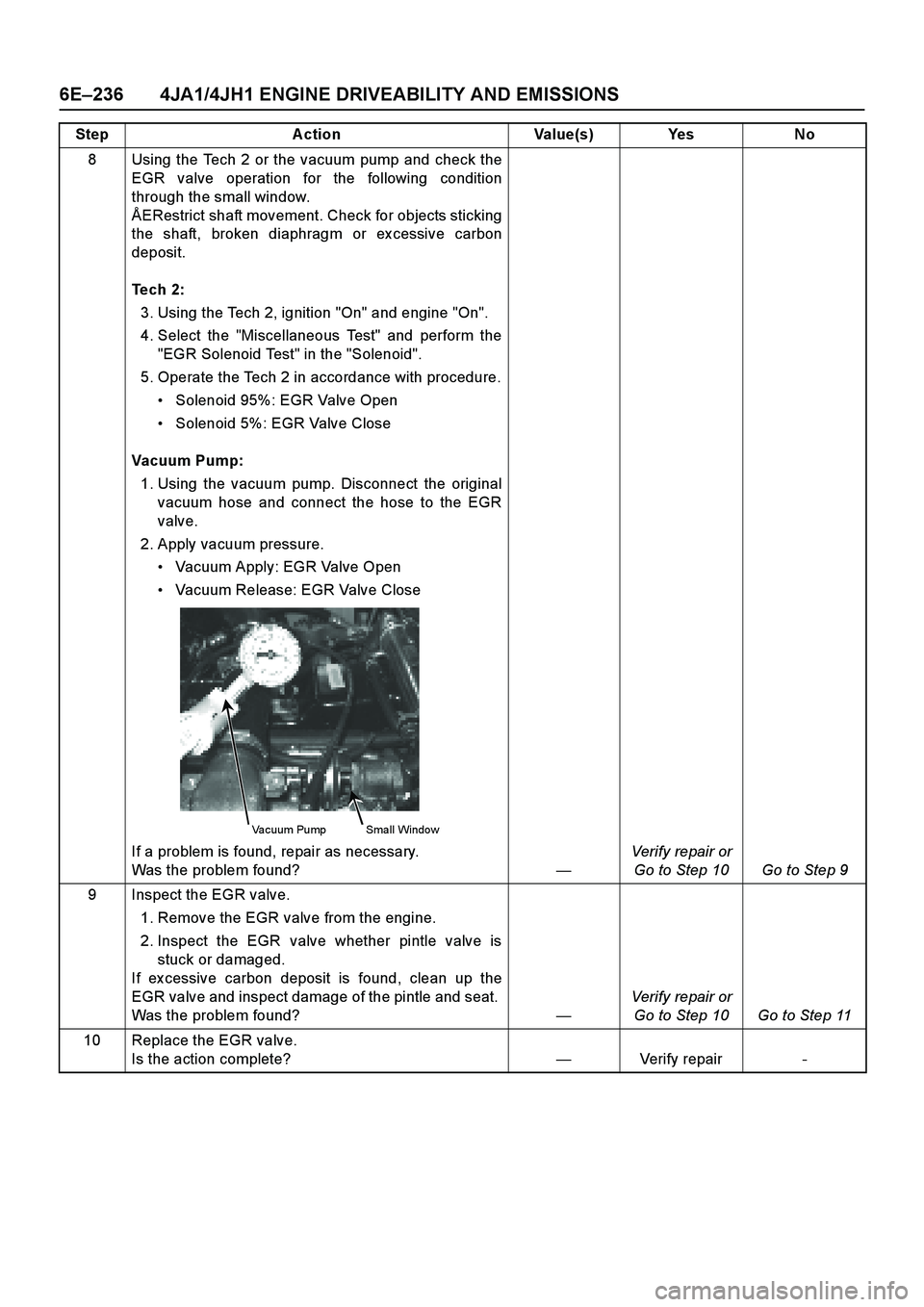
6E–236 4JA1/4JH1 ENGINE DRIVEABILITY AND EMISSIONS
8 Using the Tech 2 or the vacuum pump and check the
EGR valve operation for the following condition
through the small window.
ÅERestrict shaft movement. Check for objects sticking
the shaft, broken diaphragm or ex cessive carbon
deposit.
Tech 2:
3. Using the Tech 2, ignition "On" and engine "On".
4. Select the "Miscellaneous Test" and perform the
"EGR Solenoid Test" in the "Solenoid".
5. Operate the Tech 2 in accordance with procedure.
Solenoid 95%: EGR Valve Open
Solenoid 5%: EGR Valve Close
Vacuum Pump:
1. Using the vacuum pump. Disconnect the original
vacuum hose and connect the hose to the EGR
valve.
2. Apply vacuum pressure.
Vacuum Apply: EGR Valve Open
Vacuum Release: EGR Valve Close
If a problem is found, repair as necessary.
Was the problem found?—Verify repair or
Go to Step 10 Go to Step 9
9 Inspect the EGR valve.
1. Remove the EGR valve from the engine.
2. Inspect the EGR valve whether pintle valve is
stuck or damaged.
If ex cessive carbon deposit is found, clean up the
EGR valve and inspect damage of the pintle and seat.
Was the problem found?—Verify repair or
Go to Step 10 Go to Step 11
10 Replace the EGR valve.
Is the action complete?—Verify repair - Step Action Value(s) Yes No
Vacuum Pump Small Window
Page 1611 of 4264
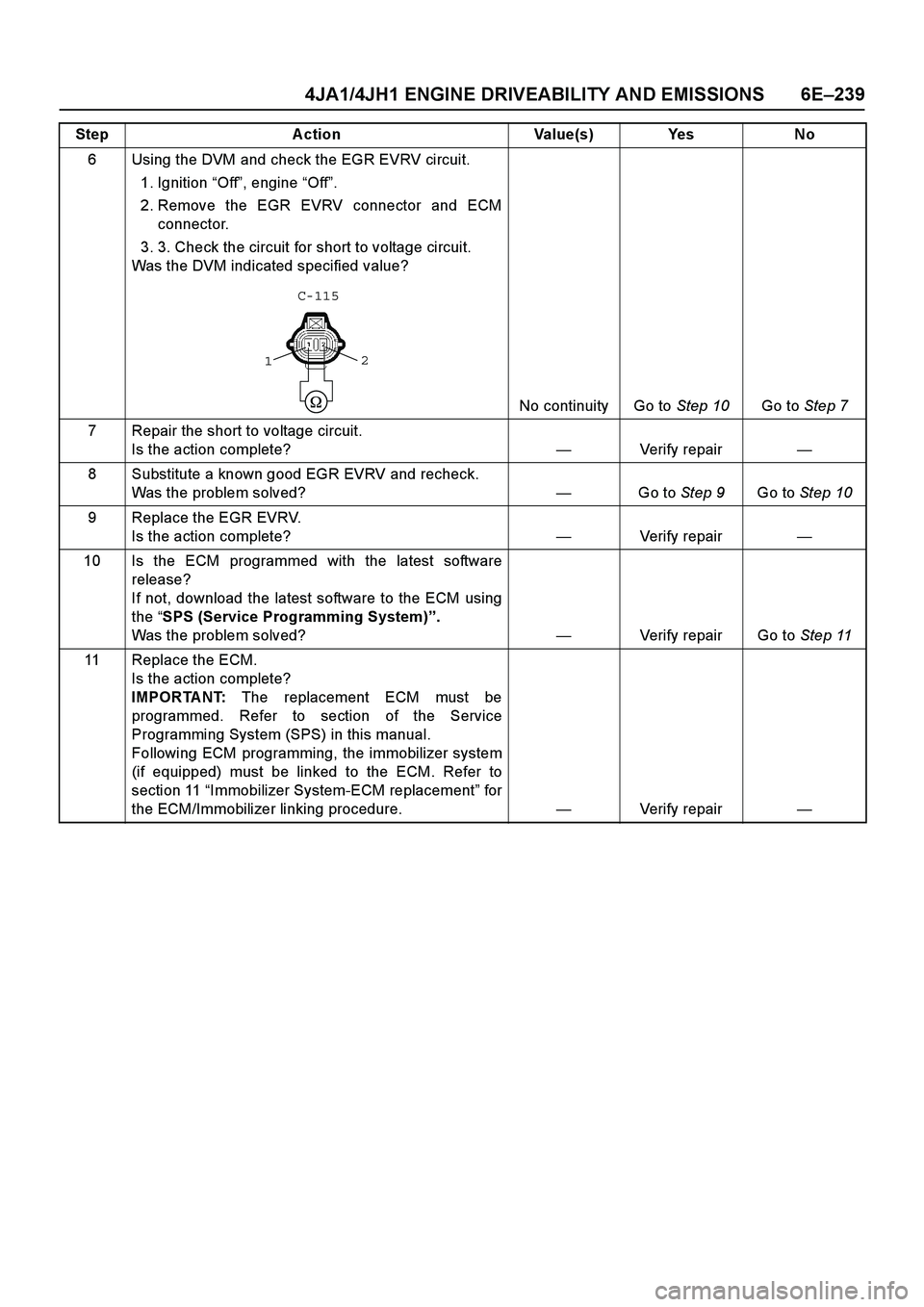
4JA1/4JH1 ENGINE DRIVEABILITY AND EMISSIONS 6E –239
6 Using the DVM and check the EGR EVRV circuit.
1. Ignition “Off ”, engine “Off ”.
2. Remove the EGR EVRV connector and ECM connector.
3. 3. Check the circuit for short to voltage circuit.
Was the DVM indicated specified value?
No continuity Go to Step 10Go to Step 7
7 Repair the short to voltage circuit. Is the action complete? —Verify repair —
8 Substitute a known good EGR EVRV and recheck. Was the problem solved? —Go to Step 9 Go to Step 10
9 Replace the EGR EVRV. Is the action complete? —Verify repair —
10 Is the ECM programmed with the latest software release?
If not, download the latest software to the ECM using
the “SPS (Service Programming System) ”.
Was the problem solved? —Verify repair Go to Step 11
11 Replace the ECM. Is the action complete?
IMPORTANT: The replacement ECM must be
programmed. Refer to section of the Service
Programming System (SPS) in this manual.
Following ECM programming, the immobilizer system
(if equipped) must be linked to the ECM. Refer to
section 11 “Immobilizer System-ECM replacement ” for
the ECM/Immobilizer linking procedure. —Verify repair —
Step Action Value(s) Yes No
1
2
C-115
Page 1614 of 4264
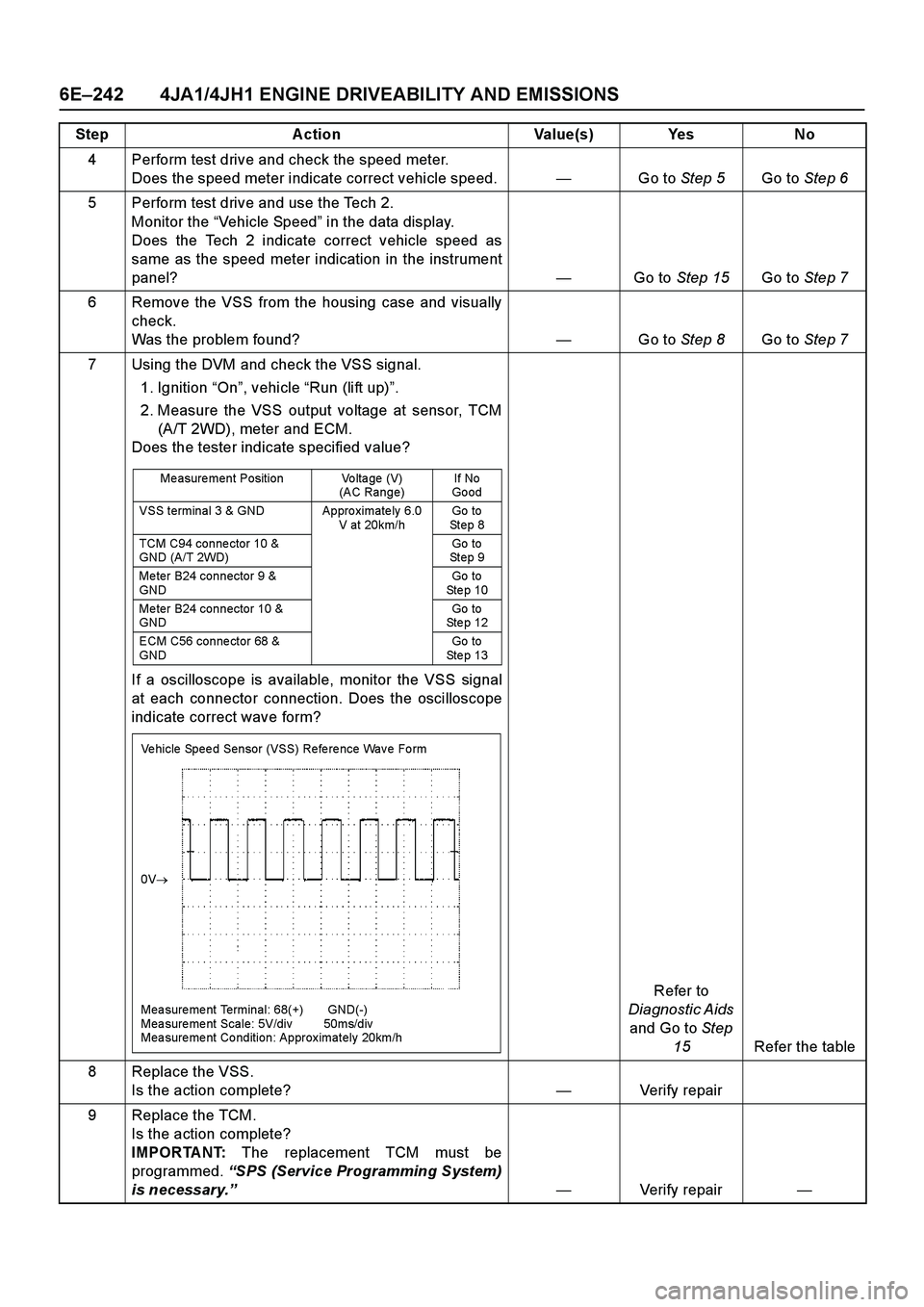
6E–242 4JA1/4JH1 ENGINE DRIVEABILITY AND EMISSIONS
4 Perform test drive and check the speed meter.
Does the speed meter indicate correct vehicle speed.—Go to Step 5Go to Step 6
5 Perform test drive and use the Tech 2.
Monitor the “Vehicle Speed” in the data display.
Does the Tech 2 indicate correct vehicle speed as
same as the speed meter indication in the instrument
panel?—Go to Step 15Go to Step 7
6 Remove the VSS from the housing case and visually
check.
Was the problem found? —Go to Step 8Go to Step 7
7 Using the DVM and check the VSS signal.
1. Ignition “On”, vehicle “Run (lift up)”.
2. Measure the VSS output voltage at sensor, TCM
(A/T 2WD), meter and ECM.
Does the tester indicate specified value?
If a oscilloscope is available, monitor the VSS signal
at each connector connection. Does the oscilloscope
indicate correct wave form?
Refer to
Diagnostic Aids
and Go to Step
15Refer the table
8 Replace the VSS.
Is the action complete?—Verify repair
9 Replace the TCM.
Is the action complete?
IMPORTANT: The replacement TCM must be
programmed. “SPS (Service Programming System)
is necessary.” —Verify repair— Step Action Value(s) Yes No
Me asure ment Position Vo lta ge (V)
(AC Range)If No
Go od
VSS terminal 3 & GND Approximately 6.0
V at 20km/hGo to
Step 8
TCM C94 conne ctor 10 &
GND (A/T 2WD)Go to
Step 9
Meter B24 connector 9 &
GNDGo to
St e p 1 0
Meter B24 connector 10 &
GNDGo to
St e p 1 2
ECM C56 connector 68 &
GNDGo to
St e p 1 3
Ve hicle Spee d Sensor (VSS) Refe re nce Wav e Fo rm
0V�
Mea sure me nt Terminal: 68(+) GND(-)
Mea sure me nt Scale: 5V/div 50ms/div
Measurement Condition: Approximately 20km/h
Page 1617 of 4264
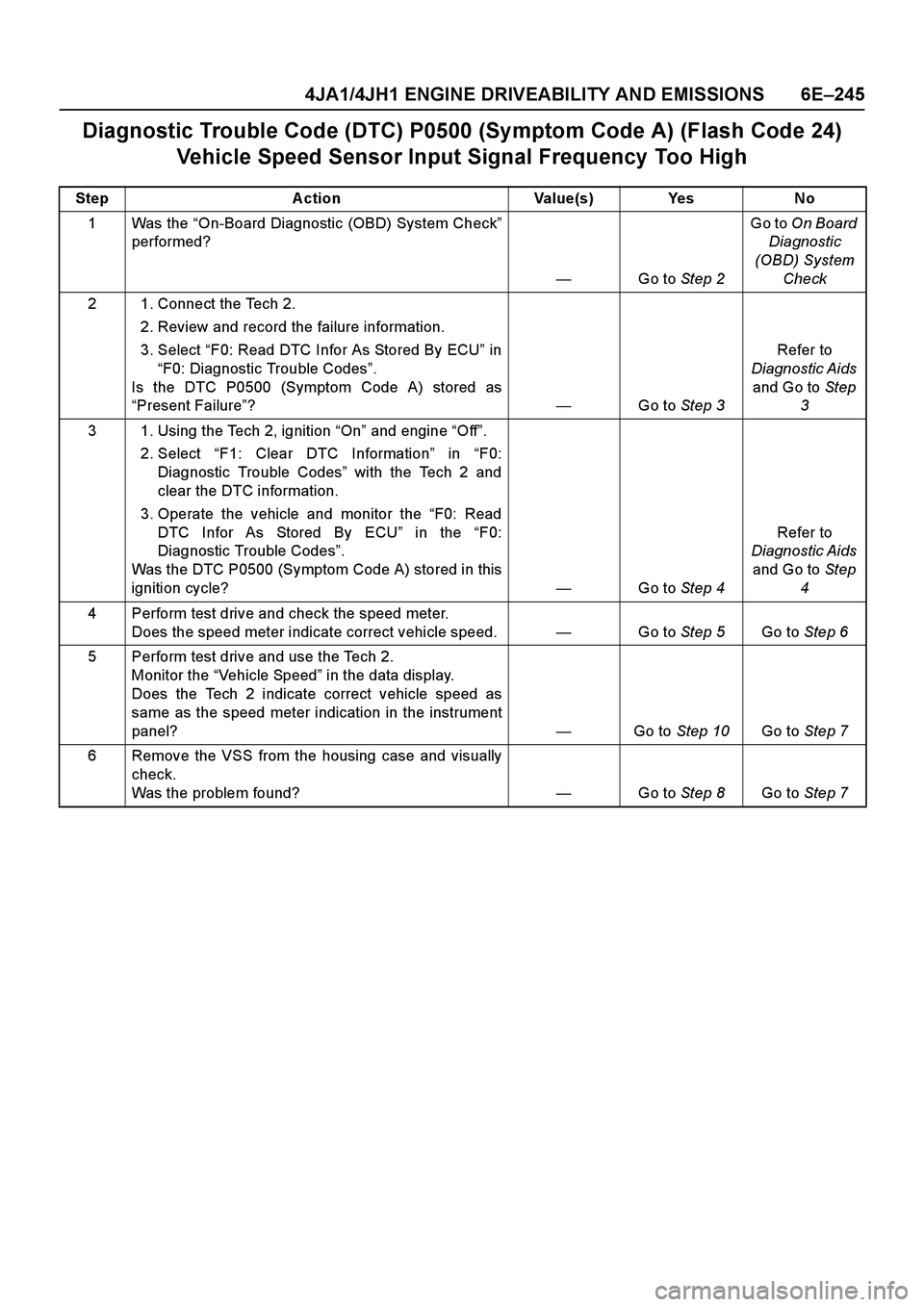
4JA1/4JH1 ENGINE DRIVEABILITY AND EMISSIONS 6E–245
Diagnostic Trouble Code (DTC) P0500 (Symptom Code A) (Flash Code 24)
Vehicle Speed Sensor Input Signal Frequency Too High
Step Action Value(s) Yes No
1Was the “On-Board Diagnostic (OBD) System Check”
performed?
—Go to Step 2Go to On Board
Diagnostic
(OBD) System
Check
2 1. Connect the Tech 2.
2. Review and record the failure information.
3. Select “F0: Read DTC Infor As Stored By ECU” in
“F0: Diagnostic Trouble Codes”.
Is the DTC P0500 (Symptom Code A) stored as
“Present Failure”?—Go to Step 3Refer to
Diagnostic Aids
and Go to Step
3
3 1. Using the Tech 2, ignition “On” and engine “Off”.
2. Select “F1: Clear DTC Information” in “F0:
Diagnostic Trouble Codes” with the Tech 2 and
clear the DTC information.
3. Operate the vehicle and monitor the “F0: Read
DTC Infor As Stored By ECU” in the “F0:
Diagnostic Trouble Codes”.
Was the DTC P0500 (Symptom Code A) stored in this
ignition cycle?—Go to Step 4Refer to
Diagnostic Aids
and Go to Step
4
4 Perform test drive and check the speed meter.
Does the speed meter indicate correct vehicle speed.—Go to Step 5Go to Step 6
5 Perform test drive and use the Tech 2.
Monitor the “Vehicle Speed” in the data display.
Does the Tech 2 indicate correct vehicle speed as
same as the speed meter indication in the instrument
panel?—Go to Step 10Go to Step 7
6 Remove the VSS from the housing case and visually
check.
Was the problem found? —Go to Step 8Go to Step 7
Page 1618 of 4264
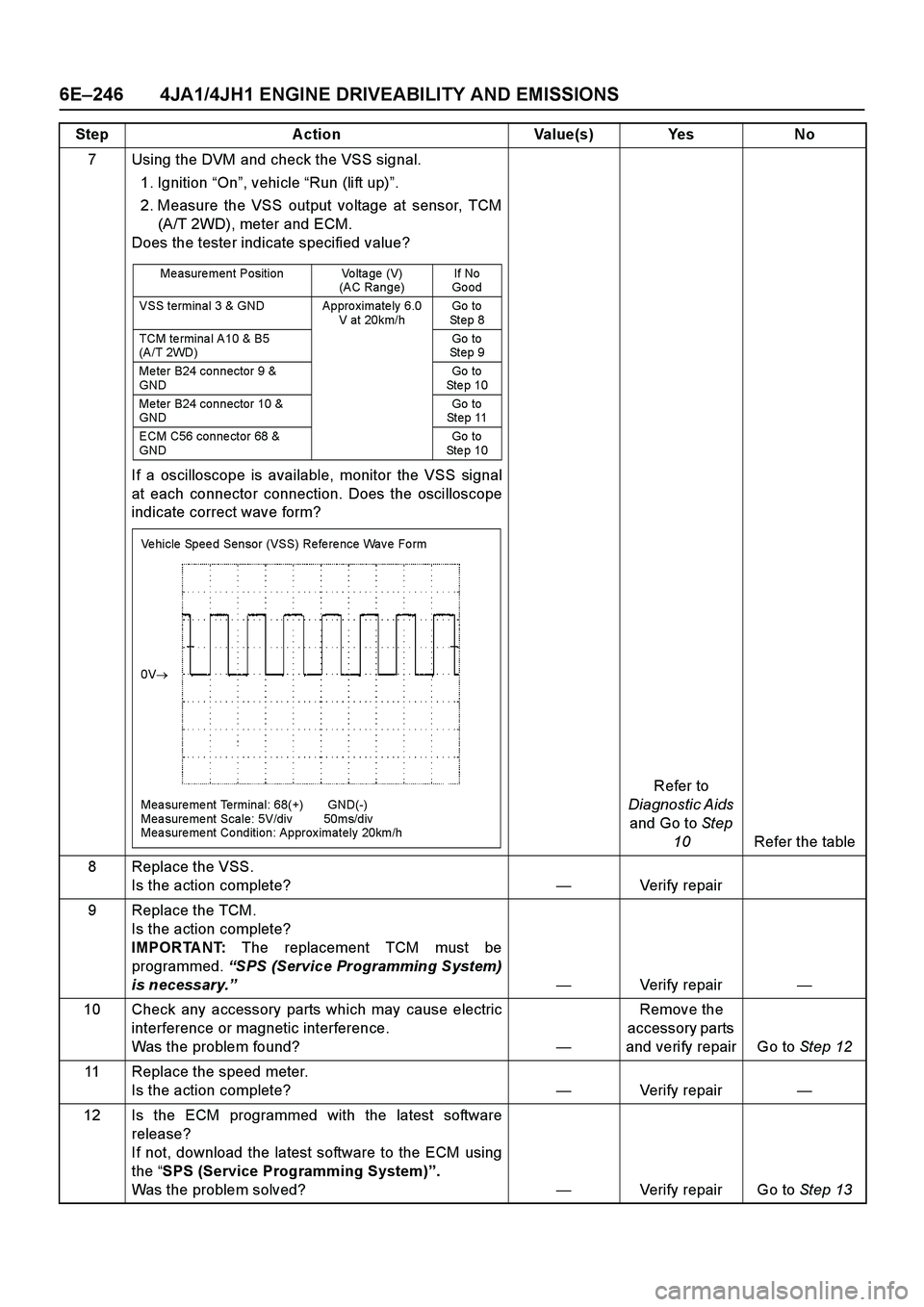
6E–246 4JA1/4JH1 ENGINE DRIVEABILITY AND EMISSIONS
7 Using the DVM and check the VSS signal.
1. Ignition “On”, vehicle “Run (lift up)”.
2. Measure the VSS output voltage at sensor, TCM
(A/T 2WD), meter and ECM.
Does the tester indicate specified value?
If a oscilloscope is available, monitor the VSS signal
at each connector connection. Does the oscilloscope
indicate correct wave form?
Refer to
Diagnostic Aids
and Go to Step
10Refer the table
8 Replace the VSS.
Is the action complete?—Verify repair
9 Replace the TCM.
Is the action complete?
IMPORTANT: The replacement TCM must be
programmed. “SPS (Service Programming System)
is necessary.” —Verify repair—
10 Check any accessory parts which may cause electric
interference or magnetic interference.
Was the problem found?—Remove the
accessory parts
and verify repair Go to Step 12
11 Replace the speed meter.
Is the action complete?—Verify repair—
12 Is the ECM programmed with the latest software
release?
If not, download the latest software to the ECM using
the “SPS (Service Programming System)”.
Was the problem solved?—Verify repair Go to Step 13 Step Action Value(s) Yes No
Me asure ment Position Vo lta ge (V)
(AC Range)If No
Go od
VSS terminal 3 & GND Approximately 6.0
V at 20km/hGo to
Step 8
TCM te rmina l A10 & B5
(A/T 2WD)Go to
Step 9
Meter B24 connector 9 &
GNDGo to
St e p 1 0
Meter B24 connector 10 &
GNDGo to
Step 11
ECM C56 connector 68 &
GNDGo to
St e p 1 0
Ve hicle Spee d Sensor (VSS) Refe re nce Wav e Fo rm
0V�
Mea sure me nt Terminal: 68(+) GND(-)
Mea sure me nt Scale: 5V/div 50ms/div
Measurement Condition: Approximately 20km/h
Page 1621 of 4264
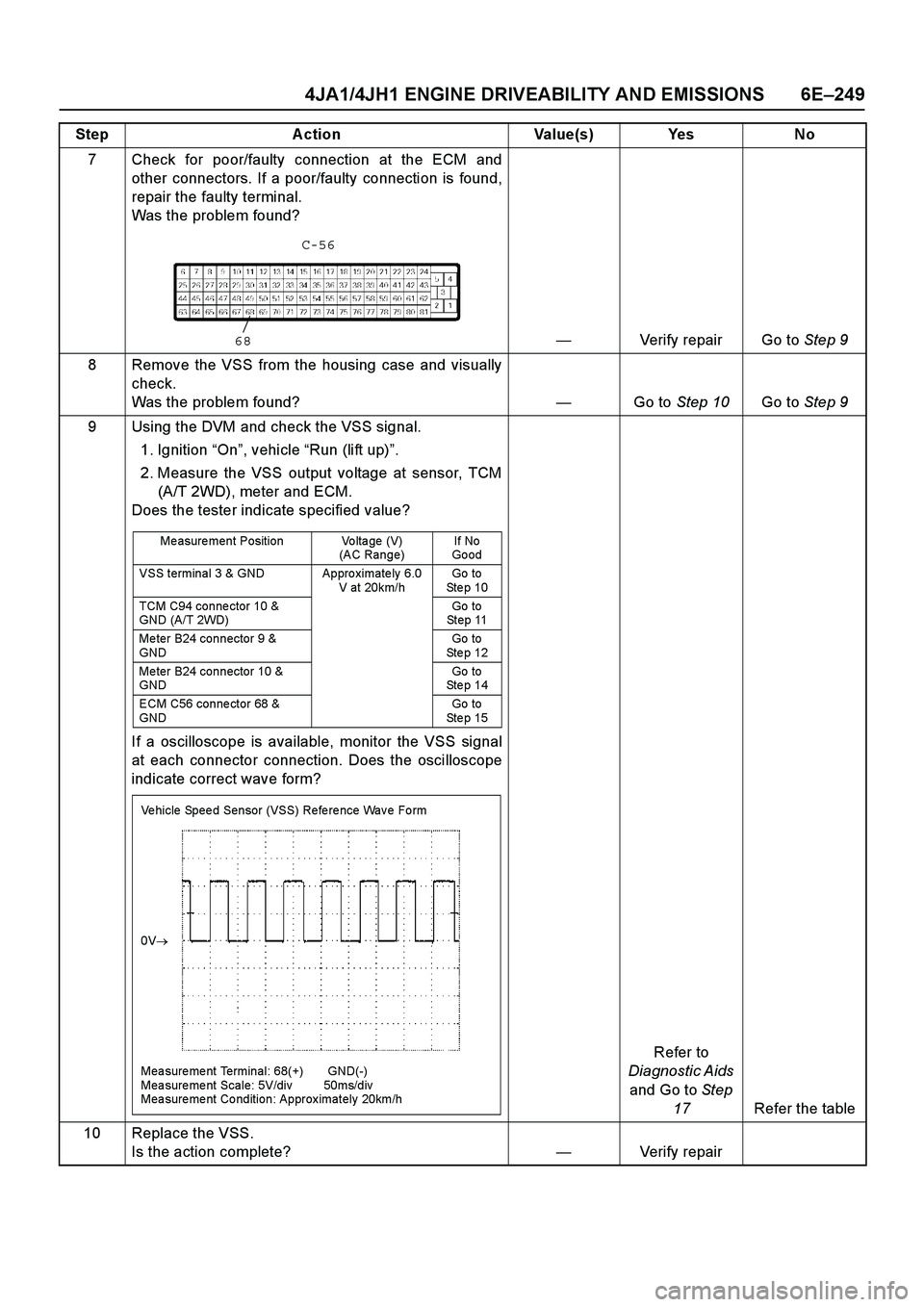
4JA1/4JH1 ENGINE DRIVEABILITY AND EMISSIONS 6E –249
7 Check for poor/faulty connection at the ECM and
other connectors. If a poor/faulty connection is found,
repair the faulty terminal.
Was the problem found?
— Verify repair Go to Step 9
8 Remove the VSS from the housing case and visually
check.
Was the problem found? —Go to Step 10 Go to Step 9
9 Using the DVM and check the VSS signal. 1. Ignition “On ”, vehicle “Run (lift up) ”.
2. Measure the VSS output voltage at sensor, TCM (A/T 2WD), meter and ECM.
Does the tester indicate specified value?
If a oscilloscope is available, monitor the VSS si gnal
at each connector connection. Does the oscilloscope
indicate correct wave form?
Refer to
Diagnostic Aids
and Go to Step
17 Refer the table
10 Replace the VSS. Is the action complete? —Verify repair
Step Action Value(s) Yes No
68
C-56
Me asure ment Position Vo lta ge (V)
(AC Range) If No
Go od
VSS terminal 3 & GND Approximately 6.0 V at 20km/h Go to
St e p 1 0
TCM C94 conne ctor 10 &
GND (A/T 2WD) Go to
Step 11
Meter B24 connector 9 &
GND Go to
St e p 1 2
Meter B24 connector 10 &
GND Go to
St e p 1 4
ECM C56 connector 68 &
GND Go to
St e p 1 5
Ve hicle Spee d Sensor (VSS) Refe re nce Wav e Fo rm
0V �
Mea sure me nt Terminal: 68(+) GND(-)
Mea sure me nt Scale: 5V/div 50ms/div
Measurement Condition: Approximately 20km/h